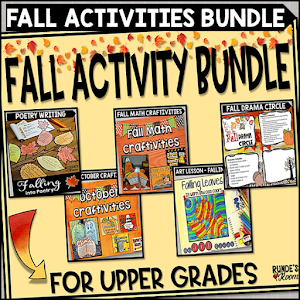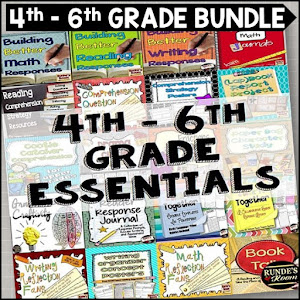We've been focusing a lot on writing reflections lately. As we're moving towards student-led parent conferences in my classroom this year, I wanted to make sure all the students had a great base piece for their portfolios - reflecting on their writing and improvements at each stage so they can clearly communicate where their starting points were, as well as what goals they are working towards mastering.
My go-to writing resource at the beginning of the year is Paragraph of the Week from Teaching in Room 6 (you can read more about this resource on her blog by clicking HERE). The clear and easy-to-follow step-by-step scaffolded paragraph writing practice is the perfect starting point for my students.
When we have finished our rough drafts of the paragraph, we then use my Revising and Editing Resource to go through our writing pieces one step at a time. Through this process, students color code their writing as they look for each expectation - from structure to mechanics. As they code, they write a short reflection on a sticky note. At the end of this activity, they take their sticky notes and fill in a full reflection sheet where they discuss their strengths and needs, and make plans for revision for their final good copies. This reflection sheet is also included in the Revising and Editing Resource.

 Students then use these reflections when writing and publishing their good copies. At the end of the publishing process, students complete a final Traffic Light Reflection before they hand in their good copies. I added a small copy of the rubric included in Paragraph of the Week to the reflection sheet so I could provide feedback right on their reflection sheet. I love these quick reflections - quick and easy for the students, and the fact that they have to go back to their published copies and provide evidence for their reflection by color coding their work really helps them keep their reflections and goals specific and achievable. And I really really love that I get to read little gems like this one below while I'm marking. :) Her "green" reflection - what she's most proud of - just makes me smile.
Students then use these reflections when writing and publishing their good copies. At the end of the publishing process, students complete a final Traffic Light Reflection before they hand in their good copies. I added a small copy of the rubric included in Paragraph of the Week to the reflection sheet so I could provide feedback right on their reflection sheet. I love these quick reflections - quick and easy for the students, and the fact that they have to go back to their published copies and provide evidence for their reflection by color coding their work really helps them keep their reflections and goals specific and achievable. And I really really love that I get to read little gems like this one below while I'm marking. :) Her "green" reflection - what she's most proud of - just makes me smile. At the end of the traffic light reflection, each student had to set a personal writing goal. They were given a clothespin to mark the goal on the Writing Goals Clip Chart in our classroom. This chart is a daily visual reminder of their goals and has been so helpful in the classroom. The students take control of their learning - coming to me when they believe they have mastered a goal (with writing pieces as proof), and get so excited to be able to clip their pin onto a new goal. (Each clothespin has the name of a student written on it - you can't see it in the picture because I blurred out the names).
At the end of the traffic light reflection, each student had to set a personal writing goal. They were given a clothespin to mark the goal on the Writing Goals Clip Chart in our classroom. This chart is a daily visual reminder of their goals and has been so helpful in the classroom. The students take control of their learning - coming to me when they believe they have mastered a goal (with writing pieces as proof), and get so excited to be able to clip their pin onto a new goal. (Each clothespin has the name of a student written on it - you can't see it in the picture because I blurred out the names).
All these sheets - their rough copies, reflection sheets, good copies, and traffic light reflection get stapled together and kept in their portfolios after I conference quickly to provide feedback with each student. Before they begin their next writing piece, they get these sheets out of their portfolios so they can see where they want to try to make improvements in their next piece. Watching them go back through their reflections, seeing them think about their writing, and helping them actively make improvements to their writing is such a rewarding process for all of us. They also do quick pair-shares with their "elbow buddies" to show and prove where they made their improvements during the writing process for each piece.
 If all of this process seems daunting - don't get overwhelmed - it's actually pretty simple. We break down this process quite a bit. Students spend about 4 days writing their pieces (from the paragraph of the week to longer pieces like the Halloween narratives we're working on now), then one to two days on the revision and editing process, including first reflection (depending on the length of the writing piece), another day or two on their good drafts (including publishing them), and then one more day on their traffic light reflections before handing in. Each day I provide them with about 20 - 30 minutes of writing time (on publishing days we may take a little longer). Each full writing piece from start to finish takes about two weeks of these writing blocks - and results in a wonderfully polished and substantially improved piece of work. When they focus on their reflections at each stage and use these reflections to improve the next piece they write, they are always amazed at how much their writing improves from piece to piece (and so am I).
If all of this process seems daunting - don't get overwhelmed - it's actually pretty simple. We break down this process quite a bit. Students spend about 4 days writing their pieces (from the paragraph of the week to longer pieces like the Halloween narratives we're working on now), then one to two days on the revision and editing process, including first reflection (depending on the length of the writing piece), another day or two on their good drafts (including publishing them), and then one more day on their traffic light reflections before handing in. Each day I provide them with about 20 - 30 minutes of writing time (on publishing days we may take a little longer). Each full writing piece from start to finish takes about two weeks of these writing blocks - and results in a wonderfully polished and substantially improved piece of work. When they focus on their reflections at each stage and use these reflections to improve the next piece they write, they are always amazed at how much their writing improves from piece to piece (and so am I).EDIT: I have received many requests to share a copy of the reflection sheet I have - so I made a new one to share with you. If you would like a copy, just click HERE or on the picture to the right. I uploaded it to google drive - you just need to click the down arrow to download a copy. :)

































I would love a copy of your traffic light reflection sheet but cannot seem to find a copy in your TPT store.
ReplyDeleteVery good blog.. and great art of pics.
ReplyDeleteafter reading this post.. I am decided to see my student notebook who was taking an internship in my institute.
keep posting.
Do you change those writing goals or keep the same ones for the year?
ReplyDelete